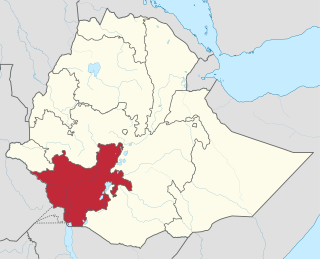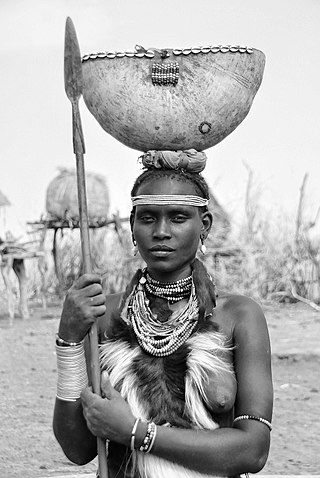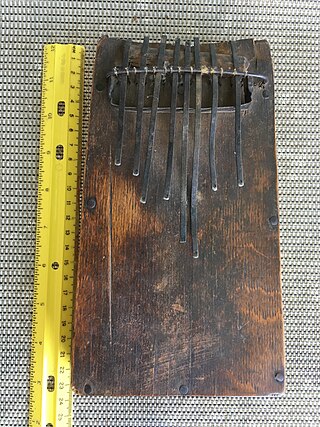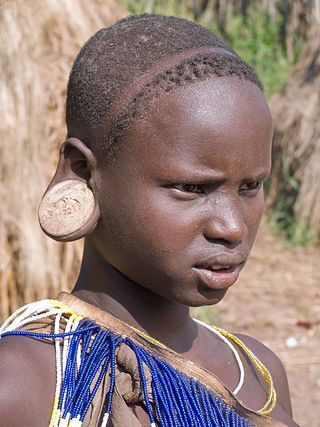The Nilotic peoples are people indigenous to the Nile Valley who speak Nilotic languages. They inhabit South Sudan, Sudan, Ethiopia, Uganda, Kenya, the eastern border area of Democratic Republic of the Congo, Rwanda, Burundi and Tanzania. Among these are the Burun-speaking peoples, Teso people also known as Iteso or people of Teso, Karo peoples, Luo peoples, Ateker peoples, Kalenjin peoples, Karamojong people also known as the Karamojong or Karimojong, Datooga, Dinka, Nuer, Atwot, Lotuko, and the Maa-speaking peoples.

The Southern Nations, Nationalities, and Peoples' Region was a regional state in southwestern Ethiopia. It was formed from the merger of five kililoch, called Regions 7 to 11, following the regional council elections on 21 June 1992. Its government was based in Hawassa.

In most classifications, the Eastern Sudanic languages are a group of nine families of languages that may constitute a branch of the Nilo-Saharan language family. Eastern Sudanic languages are spoken from southern Egypt to northern Tanzania.

The Mursi are a Surmic ethnic group in Ethiopia. They principally reside in the Debub Omo Zone of the Southern Nations, Nationalities, and People's Region, close to the border with South Sudan. According to the 2007 national census, there are 11,500 Mursi, 848 of whom live in urban areas; of the total number, 92.25% live in the Southern Nations, Nationalities, and People's Region (SNNPR).

The Shilluk is a major Luo Nilotic ethnic group that resides in the northeastern Upper Nile state of South Sudan on both banks of the Nile River in Malakal. Before the Second Sudanese Civil War, the Shilluk also lived in settlements on the northern bank of the Sobat River, close to where the Sobat joins the Nile.
The Surmic languages are a branch of the Eastern Sudanic language family.

The Rendille are a Cushitic ethnic group inhabiting the Eastern Province of Kenya.

The Murle are a Surmic ethnic group inhabiting the Pibor County and Boma area in Greater Pibor Administrative Area, South Sudan, as well as parts of southwestern Ethiopia. They have also been referred as Beir by the Dinka and as Jebe by the Luo and Nuer, among others. The Murle speak the Murle language, which is part of the Surmic language family. The language cluster includes some adjoining groups in Sudan, as well as some non-contiguous Surmic populations in southwestern Ethiopia.
Meʼen is a Nilo-Saharan language spoken in Ethiopia by the Meʼen people. In recent years, it has been written with the Geʽez alphabet, but in 2007 a decision was made to use the Latin alphabet. Dialects include Bodi (Podi) and Tishena.
Shanqella is an exonym for a number of Nilotic ethnic groups that lived in the westernmost part of Ethiopia, but are known to have also inhabited more northerly areas until the late nineteenth century. A pejorative, the term was traditionally used by the local Afro-Asiatic-speaking populations to refer in general terms to darker-skinned ethnic groups, particularly to those from communities speaking Nilo-Saharan languages of Western Ethiopia. These were regarded as primitive people and slave reserves by the Abyssinians.

The Daasanach are an ethnic group inhabiting parts of Ethiopia, Kenya, and South Sudan. Their main homeland is in the Debub Omo Zone of the Southern Nations, Nationalities, and People's Region, adjacent to Lake Turkana. According to the 2007 national census, they number 48,067 people, of whom 1,481 are urban dwellers.

The Datooga,, are a Nilotic ethnic people group from Karatu District of Arusha Region and historically in areas of south west Manyara Region, and northern Singida Region of Tanzania. In 2000 the Datooga population was estimated to number 87,978.
Selamago is a woreda in the Southern Nations, Nationalities, and Peoples' Region of Ethiopia. Part of the Debub Omo Zone, Selamago is bordered on the south by Nyangatom, on the west and north by the Omo River which separates it from the Bench Maji, Keffa and Konta, on the northeast by the Gamo Gofa, on the east by the Basketo and Bako Gazer, and on the southeast by the Usno River which separates it from Bena Tsemay; the Mago River defines part of the boundary with Bako Gazer. The administrative center of Selamago is Hana.

The Majang people, or Majangir, live in southwestern Ethiopia and speak a Nilo-Saharan language of the Surmic cluster. The 1998 census gave the total of the Majangir population as 15,341, but since they live scattered in the hills in dispersed settlements, their actual total number is undoubtedly much higher. They live around cities of Tepi, Mett'i, and scattered southwest of Mizan Teferi and towards Gambela.

The Majang language is spoken by the Majangir people of Ethiopia. Although it is a member of the Surmic language cluster, it is the most isolated one in the group. A language survey has shown that dialect variation from north to south is minor and does not seriously impede communication. The 2007 Ethiopian Census lists 6,433 speakers for Majang (Messengo), but also reports that the ethnic group consists of 32,822 individuals. According to the census, almost no speakers can be found in Mezhenger Zone of Gambela Region; a total of eleven speakers are listed for the zone, but almost 10,000 ethnic Mejenger or Messengo people.

The Kwegu are an ethnic group that lives on the western banks of the Omo River in the newly formed South Ethiopia Region. Some members of the Kwegu also live on the eastern banks of the river among the Mursi. Previously they were hunter-gatherers, but today they are engaged in a mixed economy of hunting, farming, beekeeping, and fishing.
Suri, is a Surmic language spoken in the West Omo Zone of the South West Ethiopia Peoples' Region in Ethiopia, to the South Sudan border by the Suri. The language has over 80% lexical similarity to Mursi. The language is often referred to by another form of its name, Surma, after which the Surmic branch of Eastern Sudanic is named, but that form is frequently used for the three related languages spoken by the Surma people: Suri, Mursi, and Me'en.

Suri is a collective name for three ethnic groups mainly living in Suri woreda, in southwestern Ethiopia. They share many similarities politically, territorially, culturally and economically but speak different languages. They all speak South East Surmic languages within the Nilo-Saharan language family, which includes the Mun, Majang, and Me'en people's languages.

South Sudan is home to around 60 indigenous ethnic groups and 80 linguistic partitions among a 2021 population of around 11 million. Historically, most ethnic groups were lacking in formal Western political institutions, with land held by the community and elders acting as problem solvers and adjudicators. Today, most ethnic groups still embrace a cattle culture in which livestock is the main measure of wealth and used for bride wealth.












